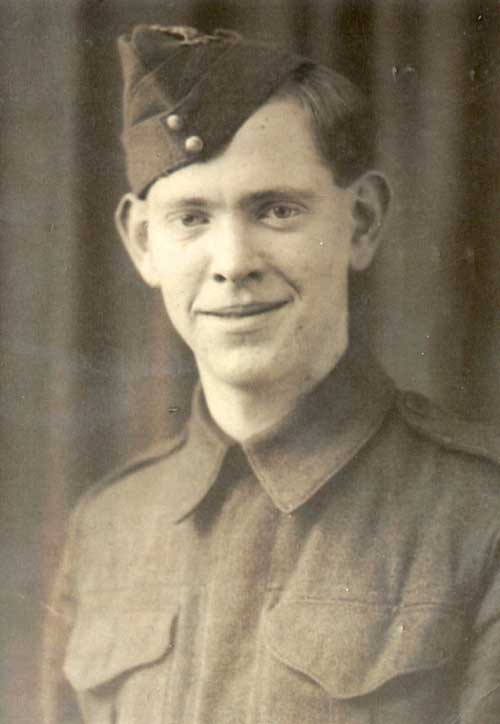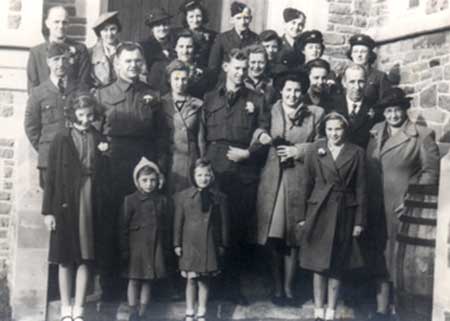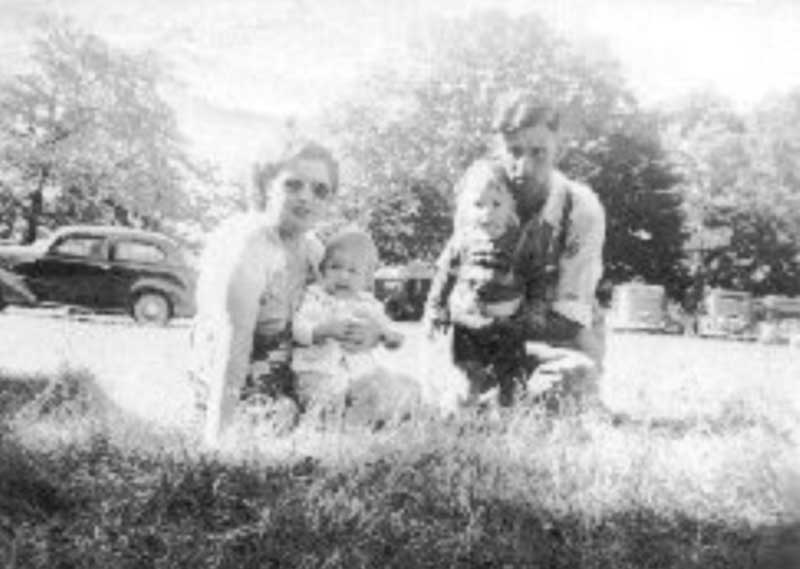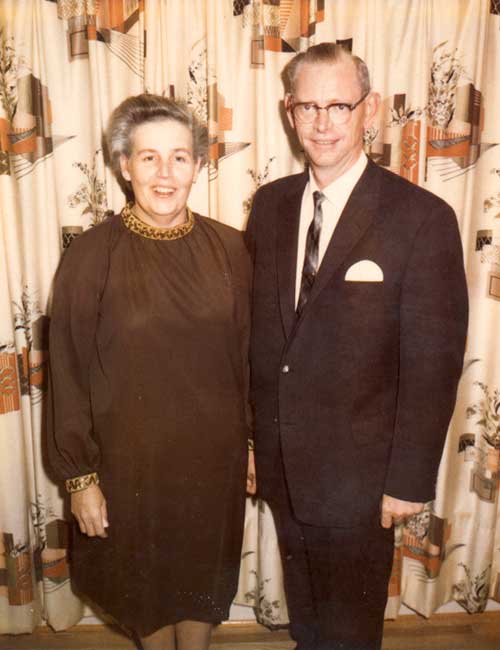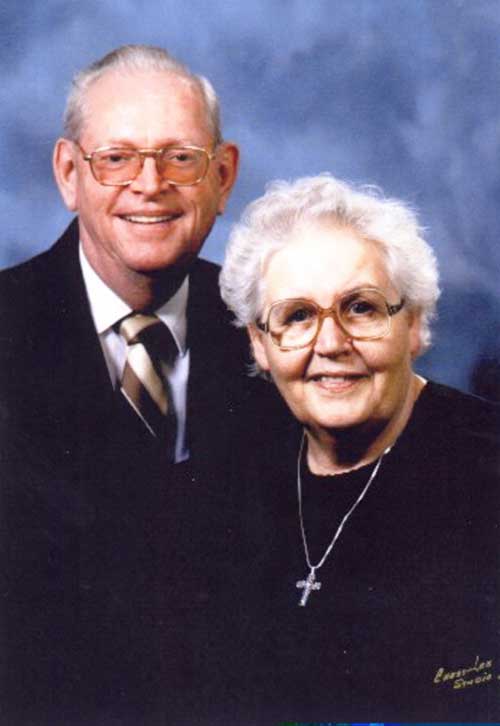Wall of Service
Column
21
Row
25
By Elsie Mills
I stood at the window today looking across a field of sweet corn. So many years have passed and so much has happened. It’s August, 1999, a beautiful day. The sun is shining and the sky looks so huge. That was the first impression I had of Canada, May 25th, 1945.
I was 6th of 10 children; my father was a constructor, working for the Admiralty in England. I started working in a hospital in London, England and had chosen nursing for a career, but Psychiatric work was difficult. My father, having moved out of Admiralty Headquarters in London, England, was relocated to the Pump Room Hotel in Bath which was temporarily turned into offices for the duration of the war. My father relocated my mother and younger family members to Bristol, so I changed hospitals and relocated to Fishponds Hospital, Bristol, to be close to them. Bombs dropped frequently, and air raid sirens went every night. Women were being called up to join the services. I was in a reserved job, but decided to join the air force as a W.A.A.F. and took job training as a dental clerk orderly. I was posted to Paignton, Devon and the fickle finger of fate stirred the pot. My Canadian husband-to-be was in a convalescent hospital in Brixham, Devon about 10 miles from Paignton. I was on duty the night we met and wasn’t supposed to be at a dance, but I was! Ed was with a group that had come over to the dance. He had run out of money to get back, so I staked him to a taxi ride. I always told him I just married him to make sure he paid me back and I still say he didn’t!
We were married for 48 years and have 4 children. The oldest, Ian, was 9 months old when we arrived in Canada, and the eldest girl was born 8 months later. We have 9 grandchildren and 8 great grandchildren.
Ed rejoined the army in 1948 and served until 1968 and with his war service completed 26 years active service.
Life was always interesting, living in Ontario, Quebec, back to Ontario, Germany, and Manitoba. Ed served in Holland and England during the war, and Cyprus, Korea and Germany as a Peacekeeper. I found life very busy but, with his frequent absence, it was a lonely life. I have lived in all shapes and sizes of houses. The smallest was at Wasaga Beach, Ontario when Ed came back from Korea. It was so small that the bedrooms only held a bed and dresser, and we had to crawl over the bed to get in the room. There was a river running along the bottom of the property and Ian used to sweet talk the fishermen out of a fish almost every week. That was a lot better though than the H-hut we lived in at Wolseley Barracks in London, Ontario. We really had to watch out for rats, coming up the standing pipe there. We learned to shove paper around the pipe and as they were pulled down we put more around the top.
In 1949, pay in the army was really poor and good homes hard to find. Polio was a constant summer-time threat and bulbar polio visited us. Our eldest daughter, Betty, was one sick lass, but she is tough and she survived and off we went to Montreal. We lived above a restaurant. The kids loved it, and visited downstairs frequently.
In Germany, we lived above a butcher shop and saw some strange ways of curing meat. I have never really enjoyed hot dogs since. We moved to P.M.Q.’s (permanent married quarters) in Soest and Werl, Germany. They were really nice three bedroom, beautifully furnished apartments. We moved to Winnipeg, Manitoba and our furniture, after four years in storage, when it finally came, smelled bad, and took only a year to fall apart. It seems it had been in a flood while we were away. The army doesn’t believe in compensation, and you sign papers that you won’t talk to the media, so, like a good soldier, you accept life and get on with it. We moved into a little house in Winnipeg P.M.Q.’s. During the winter the upstairs bedroom wall would freeze and with it, any sheet or blanket that touched it. How cold does it get in Winnipeg? Answer: so cold that if you hang washing on the line, it snaps right off, leaving the pegs and anything attached; example - hems, pant tops, or feet of socks there until spring. No kidding!
In 1968, Ed had been really sick, so he decided to retire from the army. We came back to London, Ontario to be close to his family.
My mother died in 1953 while we were stationed in Montreal and my father died in 1955 while we were in Camp Borden. I had the opportunity to return to England in 1958 with my children on the way to join my husband in Germany, and although I hadn’t been able to see my parents again, I had the opportunity to revisit the rest of my family. In Halifax, however, is a reminder of my father’s expertise. The Admiralty anchor that is on the Corvette, was the anchor modified by my father. Anchors at one time used to be pulled up by hawser and put on the deck. Mr. Alfred Nash, my father, modified it to allow it to slide up the outside of the ship and lock into the side. The first of these anchors were put on an Indian Line of ships in 1936.
What a shock to an English War Bride to come from a home that was planned and built by my father, to a terrace house, with a pump in the well for water, a loo down the garden, snow in the winter that was pushed back to the hydro wires, where the doctor traveled on snowshoes to visit his patients, and they dropped yeast to make bread and other emergency commodities by parachute until they blasted the snow so the trains could get through during one very difficult winter. I wanted to go home, but I didn’t. The girls the Canadian soldiers brought home as brides were tough but then they had endured four years of war, hadn’t they?
Elsie’s speech from Canada Day 2002 when she presented Ruby Fletcher’s lucky horseshoe to Pier 21
I came to Canada in May of 1945 when I was 22, with a 9 month old son, expecting another child. I had just found out I was pregnant the day I left.
The trip over was 2 very long weeks; a very rough passage, anchoring at the Azores because of suspected submarines still in the Atlantic. Grief felt for a young mother whose baby died and was buried at sea from HMS Britannic, didn't help any of us feel better. Arriving at Pier 21, (at that time just a big shed that we identified our luggage in), and then walked through to the train that was waiting for us to take us on to wherever. I personally was numb, I had no idea what was facing me, but at least the earth was still and wasn't rocking up and down. I traveled through Nova Scotia, and thought, what a beautiful place, I know I am going to love it here, all the little lakes and then beautiful scenery, I really thought that all of Canada was like Nova Scotia. But of course it isn't, it is all different, and has a beauty that belongs to each part. Pier 21 belongs to all that saw Canada, first by stepping out from its shed, into a world of who knew what? None of us knew what was in store for us, but took that step anyway. I came back on a visit, and came to Pier 21 to see it.
Again, I saw the plaque that had been put up commemorating the War Brides, and then on subsequent visits the start of the museum. I was invited to write my story, which I did, and to my delight was included in the book written by Linda Granfield, Brass Buttons and Silver Horseshoes - The Story of Canada's British War Brides. I have been a member of Pier 21 for quite a while now. Ruth Goldbloom, past president of Pier 21, put me in mind of that hymn we used to sing as little children - This little light of mine, I'm going to let it shine. I would like to see that light shine in all of us that came through Pier 21. Just imagine if we all sent in our stories and made a library of them; if all whose parents or grandparents came through here became members, what a showplace this would be.
Linda Granfield was giving a book talk, so I was able to meet her. Linda said that Pier 21 was in need of a horseshoe that had been carried by a War Bride for the museum. I was talking to a group of my friends, one Ruby Fletcher, was willing to donate a horse shoe she carried at her wedding and I bring it to you today.
Research tells us the horseshoe was carried by brides, because it is U-shaped, representing purity, and good luck. It is then hung by the shoulders of the horseshoe on your door. The other way would allow the good luck to fall out. It kept the devil away because he promised not to enter if he saw one. A related tradition is that it is very good luck to see a gray horse on the way to the church, even more good luck if the bride travels in a carriage drawn by a gray horse, while the luckiest of horseshoes come from the hind feet of a grey mare. Well, this paper horse shoe never saw the hind foot of a grey mare, but I hope it will bring Pier 21 and its many visitors much good fortune in the years to come.
